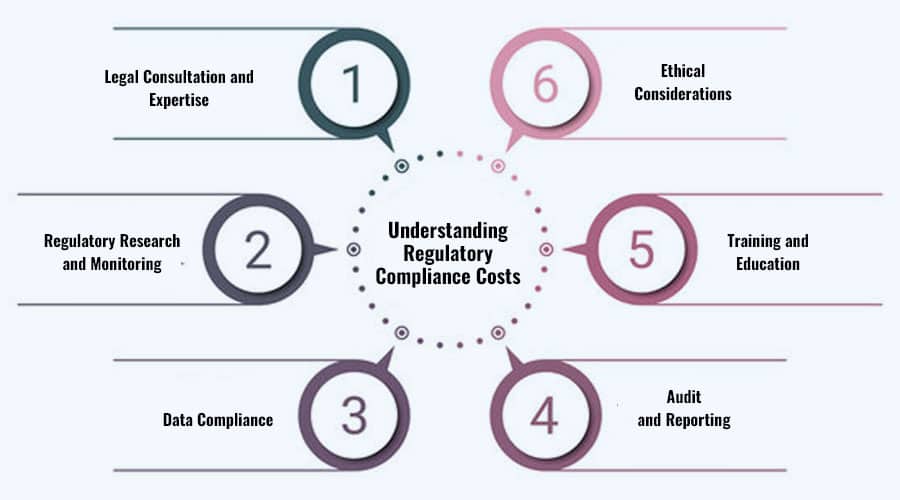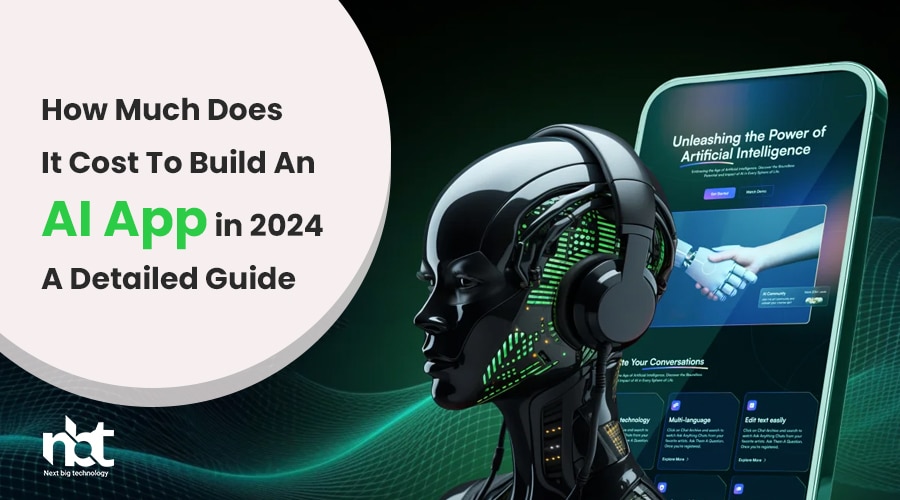Table of Contents
Introduction to AI App Development Costs
In the rapidly evolving landscape of technology, Artificial Intelligence (AI) has emerged as a transformative force across various industries. From enhancing customer experiences to streamlining business operations, the potential of AI applications is boundless. However, embarking on the journey of AI app development requires a comprehensive understanding of the associated costs.
Exploring AI App Development Costs
1. Initial Investment: Developing an AI application necessitates a significant initial investment. This investment encompasses various aspects such as hiring skilled professionals, acquiring cutting-edge tools and technologies, and setting up infrastructure. The complexity of the application and the desired functionality play a crucial role in determining the initial investment required.
2. Development Team: The backbone of any AI app development project is a proficient development team comprising data scientists, AI engineers, software developers, and UX/UI designers. The cost of hiring these professionals varies based on their expertise and experience level. Moreover, engaging a skilled team ensures the seamless execution of the project, thereby contributing to its success.
3. Data Collection and Preparation: AI applications rely heavily on data for training and learning purposes. Acquiring relevant data sets and ensuring their quality and accuracy is a critical aspect of development. Data collection, cleaning, and preparation incur significant costs, especially for applications requiring large volumes of data or specialized datasets.
4. Algorithm Development: The core functionality of an AI application revolves around sophisticated algorithms tailored to address specific tasks or challenges. Developing and fine-tuning these algorithms demands expertise and rigorous testing, adding to the overall development costs. Additionally, ongoing algorithm optimization may be necessary to enhance performance and adapt to evolving requirements.
5. Integration and Deployment: Integrating AI capabilities into an application and deploying it across various platforms require meticulous planning and execution. Compatibility issues, scalability concerns, and performance optimization are key considerations during the integration and deployment phases. Investing in robust deployment strategies ensures the seamless delivery of AI-powered solutions to end-users.
6. Maintenance and Support: Post-deployment, continuous maintenance and support are essential to ensure the optimal performance and reliability of the AI application. This includes monitoring for bugs and issues, implementing updates and enhancements, and providing timely support to address user inquiries and feedback. Allocating resources for ongoing maintenance is crucial for the long-term sustainability of the application.
Factors Affecting the Cost of AI App Development

In today’s fast-paced digital landscape, the integration of Artificial Intelligence (AI) into mobile applications has become a game-changer for businesses across various sectors. From enhancing user experiences to streamlining operations, AI-powered apps offer unprecedented opportunities. However, one crucial aspect that often perplexes both developers and businesses alike is the cost associated with AI app development.
Understanding the factors influencing the cost of AI app development is imperative for businesses planning to embark on this transformative journey. Let’s delve into the key elements that contribute to the overall expenses:
- Complexity of AI Algorithms: The complexity of AI algorithms plays a pivotal role in determining development costs. Sophisticated algorithms that require extensive data processing, deep learning, or natural language processing (NLP) tend to escalate development expenses due to the expertise and time investment required.
- Data Acquisition and Processing: High-quality data is the lifeblood of AI applications. Acquiring, cleaning, and processing vast volumes of data incur significant costs. Moreover, ensuring data privacy and security adds another layer of complexity and expense to the development process.
- Integration with External Systems: Integrating AI-powered features with existing systems or third-party APIs can substantially impact development costs. Compatibility issues, customization requirements, and API licensing fees contribute to the overall expenditure.
- User Interface and Experience (UI/UX) Design: Crafting an intuitive and visually appealing user interface is crucial for the success of any AI app. Investing in UI/UX design to seamlessly integrate AI functionalities while ensuring a smooth user experience can drive up development costs.
- Platform Compatibility: Developing AI apps that are compatible with multiple platforms such as iOS, Android, and web browsers requires additional resources and expertise. The need for platform-specific optimizations and testing further adds to the development costs.
- Scalability and Maintenance: Building scalable AI solutions capable of handling growing user demands and evolving business requirements necessitates careful planning and investment. Ongoing maintenance, updates, and performance optimization also contribute to the long-term costs of AI app development.
- Regulatory Compliance: Compliance with regulatory frameworks such as GDPR, HIPAA, or industry-specific standards imposes additional costs on AI app development. Ensuring data protection, ethical AI practices, and regulatory compliance requires meticulous planning and resources.
- Team Expertise and Skill Level: The expertise and skill level of the development team directly impact the cost of AI app development. Hiring experienced AI engineers, data scientists, and UI/UX designers comes at a premium, but it is essential for delivering high-quality AI solutions.
- Geographical Location of Development Team: The geographical location of the development team also influences costs. Development teams based in regions with higher labor costs, such as North America or Western Europe, may charge more compared to teams located in countries with lower labor costs.
- Project Timeline and Deadlines: Tight project timelines and deadlines often require additional resources and expedited development processes, which can lead to increased costs. Adequate planning and flexibility in project timelines can help mitigate such expenses.
Choosing the Right AI Technologies and Frameworks
In today’s digital era, the integration of Artificial Intelligence (AI) has become imperative for businesses striving to stay ahead of the curve. However, with the plethora of AI technologies and frameworks available, selecting the right ones for your specific needs can be a daunting task. From machine learning algorithms to deep learning frameworks, the choices seem endless. So, how do you navigate this complex landscape and make informed decisions? Let’s delve into the key factors to consider when choosing the right AI technologies and frameworks.
- Define Your Objectives: Before diving into the sea of AI options, it’s crucial to define your objectives clearly. Are you looking to enhance customer experience, optimize operations, or develop innovative products? Understanding your goals will help narrow down the options and focus on technologies that align with your business objectives.
- Assess Your Data: Data is the lifeblood of AI. Before selecting AI technologies and frameworks, assess the quality, volume, and diversity of your data. Different AI algorithms and frameworks have varying requirements in terms of data quality and quantity. Ensure that your data infrastructure is robust enough to support the chosen AI solutions.
- Understand the AI Spectrum: AI encompasses a spectrum of technologies, including machine learning, deep learning, natural language processing (NLP), computer vision, and more. Each technology has its strengths and limitations. For instance, machine learning is well-suited for predictive analytics tasks, while deep learning excels in handling unstructured data like images and texts. Understand the nuances of each technology to make informed choices.
- Consider Scalability and Flexibility: As your business grows, so will the demands on your AI infrastructure. Choose technologies and frameworks that are scalable and flexible enough to accommodate future growth and evolving requirements. Look for solutions that support distributed computing, parallel processing, and cloud integration to ensure scalability.
- Evaluate Frameworks and Tools: There is a myriad of AI frameworks and tools available, ranging from TensorFlow and PyTorch for deep learning to scikit-learn and XGBoost for traditional machine learning. Evaluate the strengths, weaknesses, and suitability of each framework based on factors such as ease of use, performance, community support, and integration capabilities with existing systems.
- Consider Regulatory and Ethical Implications: With great power comes great responsibility. AI technologies raise significant ethical and regulatory concerns, especially regarding data privacy, bias, and transparency. Choose technologies and frameworks that prioritize ethical considerations and comply with relevant regulations such as GDPR and CCPA. Transparency and interpretability are essential for building trust in AI systems.
- Invest in Talent and Expertise: Building and deploying AI solutions require specialized skills and expertise. Invest in talent development initiatives to ensure that your team possesses the necessary skills to work with the chosen technologies and frameworks effectively. Consider partnering with AI experts or engaging in training programs to bridge skill gaps.
- Stay Agile and Adaptive: The AI landscape is constantly evolving, with new technologies and frameworks emerging rapidly. Stay agile and adaptive to embrace innovation and leverage emerging trends in AI. Regularly reassess your AI strategy and be prepared to pivot based on changing market dynamics and technological advancements.
Cost Breakdown: Design and UI/UX Development

In today’s digital landscape, artificial intelligence (AI) has become a cornerstone for businesses striving to stay competitive and relevant. From streamlining processes to enhancing customer experiences, the potential applications of AI are vast and ever-expanding. However, with the myriad of AI technologies and frameworks available, selecting the right ones for your specific needs can be a daunting task. In this article, we’ll explore some key considerations to help you navigate this complex landscape and choose the AI technologies and frameworks that are best suited for your organization.
- Define Your Objectives: Before delving into the realm of AI technologies and frameworks, it’s crucial to have a clear understanding of your business objectives and the problems you aim to solve. Are you looking to automate repetitive tasks, improve decision-making processes, or enhance customer engagement? By defining your goals upfront, you can narrow down the list of potential AI solutions and focus on those that align closely with your strategic priorities.
- Assess Your Data: Data is the lifeblood of AI, and its quality and quantity play a pivotal role in the success of any AI initiative. Before selecting AI technologies and frameworks, assess the availability, accessibility, and cleanliness of your data. Do you have sufficient data volumes to train AI models effectively? Is your data structured or unstructured? Understanding your data landscape will help you determine which AI technologies are best suited for your data environment.
- Understand Different AI Technologies: AI encompasses a broad spectrum of technologies, including machine learning, deep learning, natural language processing (NLP), computer vision, and more. Each of these technologies has its strengths and weaknesses, and choosing the right one depends on the nature of your problem and the type of data you’re working with. For instance, if you’re dealing with unstructured text data, NLP technologies like BERT or GPT might be suitable, whereas computer vision frameworks like TensorFlow or PyTorch are ideal for image recognition tasks.
- Evaluate Frameworks and Tools: Once you’ve identified the AI technologies relevant to your needs, it’s time to evaluate the frameworks and tools available within each category. Popular machine learning frameworks like TensorFlow, PyTorch, and scikit-learn offer a wide range of capabilities for building and deploying AI models. Similarly, cloud-based AI services such as Amazon SageMaker, Google AI Platform, and Microsoft Azure AI provide convenient platforms for developing AI solutions without the need for extensive infrastructure setup.
- Consider Scalability and Maintenance: Scalability and maintenance are critical factors to consider when choosing AI technologies and frameworks, especially for enterprise-scale deployments. Ensure that the selected frameworks can scale seamlessly as your data volumes and computational requirements grow over time. Additionally, consider the ease of maintenance, including model retraining, performance monitoring, and debugging capabilities, to minimize operational overhead and ensure long-term sustainability.
- Keep an Eye on Emerging Trends: The field of AI is rapidly evolving, with new technologies and frameworks emerging regularly. Stay abreast of the latest developments and trends in the AI landscape to ensure that your chosen technologies remain relevant and competitive. Engage with AI communities, attend conferences, and leverage online resources to stay informed about emerging technologies and best practices in AI development.
Infrastructure Costs: Hosting, Servers, and Cloud Services
In today’s digital age, businesses rely heavily on technology infrastructure to operate efficiently and effectively. Whether you’re a startup or a large enterprise, understanding the intricacies of hosting, servers, and cloud services is essential for managing costs while ensuring optimal performance. In this guide, we’ll delve into the world of infrastructure costs, exploring the nuances of hosting options, server types, and the benefits of cloud services.
Understanding Hosting Options: When it comes to hosting, businesses have several options to consider, each with its own set of pros and cons. Shared hosting is the most economical choice, as multiple websites share resources on a single server. While this option is cost-effective, it may not provide the level of performance and security required for high-traffic websites or mission-critical applications.
On the other hand, dedicated hosting offers businesses exclusive use of a server, providing greater control, security, and performance. While dedicated hosting typically comes at a higher cost, it’s ideal for businesses with specific resource requirements or compliance needs.
Virtual Private Servers (VPS) strike a balance between shared and dedicated hosting, offering businesses dedicated resources within a virtualized environment. VPS hosting is scalable, allowing businesses to adjust resources based on demand, making it a flexible and cost-effective solution for growing businesses.
Exploring Server Types: Servers form the backbone of any digital infrastructure, powering websites, applications, and databases. Understanding the different types of servers can help businesses make informed decisions when it comes to infrastructure investments.
Traditional servers, also known as bare-metal servers, are physical machines dedicated to running specific workloads. While traditional servers offer high performance and reliability, they require significant upfront investment and ongoing maintenance.
Virtual servers, on the other hand, are software-defined instances that run on physical servers. Virtualization technology allows businesses to partition physical servers into multiple virtual machines, each with its own operating system and resources. Virtual servers are highly scalable and cost-effective, making them a popular choice for businesses of all sizes.
Cloud servers take virtualization a step further by leveraging cloud computing infrastructure to deliver on-demand computing resources over the internet. Cloud servers offer unparalleled flexibility and scalability, allowing businesses to scale resources up or down based on demand, pay only for what they use, and benefit from built-in redundancy and disaster recovery capabilities.
Harnessing the Power of Cloud Services: Cloud services have revolutionized the way businesses approach IT infrastructure, offering a wide range of services, including computing power, storage, networking, and databases, on a pay-as-you-go basis. By leveraging cloud services, businesses can reduce capital expenditures, improve agility, and focus on innovation rather than infrastructure management.
Infrastructure as a Service (IaaS) provides businesses with virtualized computing resources over the internet, including servers, storage, and networking. Platform as a Service (PaaS) abstracts away the underlying infrastructure, allowing developers to focus on building and deploying applications without worrying about hardware or operating system management.
Software as a Service (SaaS) delivers software applications over the internet on a subscription basis, eliminating the need for businesses to install, maintain, and upgrade software locally. From email and productivity tools to customer relationship management and enterprise resource planning, SaaS offerings span a wide range of applications, catering to businesses of all sizes and industries.
Optimizing Infrastructure Costs: While investing in hosting, servers, and cloud services is essential for businesses looking to stay competitive in today’s digital landscape, optimizing infrastructure costs is equally important. By carefully evaluating hosting options, choosing the right server type, and leveraging cloud services effectively, businesses can maximize ROI while ensuring scalability, performance, and security.
Regularly monitoring and optimizing resource usage, rightsizing infrastructure based on workload demands, and implementing cost-saving measures such as reserved instances and spot instances can further reduce infrastructure costs without compromising performance or reliability.
Maintenance and Support Expenses

In the realm of business operations, maintaining and supporting your assets, equipment, and systems is indispensable. These expenses, often overlooked, play a pivotal role in ensuring smooth operations, enhancing productivity, and mitigating risks. In this article, we delve into the significance of maintenance and support expenses, shedding light on their importance and how they contribute to the overall success of a business.
The Importance of Maintenance and Support Expenses
Maintenance and support expenses encompass a wide array of activities aimed at preserving and optimizing the performance of assets, machinery, software systems, and infrastructure. While some may perceive these expenses as mere financial burdens, they are, in fact, strategic investments that yield long-term benefits for businesses.
- Asset Preservation: Regular maintenance ensures that assets remain in optimal condition, thereby prolonging their lifespan. Whether it’s machinery on the factory floor or IT infrastructure powering your operations, preventive maintenance minimizes the likelihood of breakdowns and costly repairs, ultimately saving both time and money.
- Operational Efficiency: Well-maintained equipment operates more efficiently, leading to higher productivity levels and lower energy consumption. By addressing minor issues before they escalate, businesses can avoid unplanned downtime, maintain consistent output, and meet customer demands effectively.
- Safety and Compliance: Compliance with safety regulations and industry standards is paramount for any business. Maintenance activities not only keep equipment safe for operation but also ensure adherence to regulatory requirements. By prioritizing safety, businesses protect their workforce and reputation while mitigating legal risks.
- Customer Satisfaction: In today’s competitive landscape, delivering exceptional products and services is non-negotiable. Maintenance and support play a crucial role in this aspect by minimizing service disruptions, ensuring product quality, and providing prompt assistance to customers when needed. A reliable support system enhances customer satisfaction and fosters loyalty, driving repeat business and positive word-of-mouth referrals.
Components of Maintenance and Support Expenses
Understanding the breakdown of maintenance and support expenses enables businesses to allocate resources effectively and prioritize critical areas. While specific requirements vary across industries and businesses, common components include:
- Preventive Maintenance: Scheduled inspections, routine servicing, and replacement of worn-out parts to prevent breakdowns and ensure optimal performance.
- Corrective Maintenance: Repairs carried out in response to identified issues or equipment failures, including both planned and unplanned maintenance activities.
- Predictive Maintenance: Utilizing data analytics and predictive algorithms to forecast potential equipment failures and address them proactively, minimizing downtime and optimizing resource utilization.
- Software Support and Updates: Regular updates, patches, and technical support for software systems to ensure compatibility, security, and functionality.
- Training and Development: Investing in training programs to upskill employees and enhance their ability to operate and maintain equipment effectively, reducing reliance on external support.
- Emergency Support: Provision for unforeseen emergencies or critical incidents, ensuring swift resolution and minimal disruption to operations.
Optimizing Maintenance and Support Expenses
While maintenance and support expenses are essential, optimizing them is equally crucial to maximize returns on investment. Businesses can adopt several strategies to achieve this:
- Data-Driven Decision Making: Leveraging data analytics and predictive maintenance technologies to identify trends, prioritize maintenance tasks, and allocate resources efficiently.
- Outsourcing Non-Core Activities: Outsourcing routine maintenance tasks or technical support functions can be cost-effective, allowing businesses to focus on their core competencies.
- Investing in Technology: Embracing innovative technologies such as Internet of Things (IoT) sensors, AI-powered analytics, and remote monitoring solutions can streamline maintenance processes, reduce downtime, and enhance overall efficiency.
- Regular Performance Reviews: Conducting periodic reviews of maintenance activities and expenses enables businesses to identify areas for improvement, refine strategies, and adapt to evolving needs.
- Employee Engagement: Involving frontline employees in maintenance activities and decision-making processes fosters a culture of ownership and accountability, leading to better outcomes and cost savings.
Regulatory Compliance Costs for AI Applications
In the fast-evolving landscape of artificial intelligence (AI) applications, one aspect often overlooked but of paramount importance is regulatory compliance. As AI continues to permeate various sectors, from healthcare to finance and beyond, ensuring adherence to regulatory standards is not just a legal requirement but also a critical ethical obligation. However, navigating the complexities of regulatory compliance comes with its own set of challenges, not least of which is the associated costs.
Understanding Regulatory Compliance Costs

Regulatory compliance costs for AI applications encompass a broad spectrum of expenses incurred in ensuring that AI systems comply with relevant laws, regulations, and industry standards. These costs can be categorized into several key areas:
- Legal Consultation and Expertise: Engaging legal counsel with expertise in AI regulations is often the first step in ensuring compliance. Legal consultation fees can vary depending on the complexity of the regulatory landscape and the specific requirements applicable to the AI application.
- Regulatory Research and Monitoring: Staying abreast of constantly evolving regulatory frameworks is essential. This involves investing in resources to research and monitor changes in laws and regulations relevant to AI, both domestically and internationally.
- Data Compliance: Data privacy and security regulations, such as the GDPR in Europe or CCPA in the United States, impose stringent requirements on the collection, storage, and processing of personal data by AI systems. Compliance with these regulations may necessitate investment in data encryption, anonymization techniques, and robust cybersecurity measures.
- Ethical Considerations: Beyond legal requirements, ethical considerations surrounding AI usage are increasingly gaining prominence. Adhering to ethical guidelines often involves conducting ethical assessments, implementing transparency measures, and ensuring fairness and accountability in AI decision-making processes.
- Training and Education: Building internal capacity through training programs and educational initiatives is crucial for fostering a culture of compliance within organizations. Training employees on regulatory requirements and ethical best practices can help mitigate compliance risks and reduce potential penalties.
- Audit and Reporting: Regular audits of AI systems to assess compliance levels and identify potential vulnerabilities are essential. Additionally, reporting requirements mandated by regulatory authorities may incur administrative costs associated with compiling and submitting compliance reports.
Mitigating Compliance Costs
While regulatory compliance costs can be substantial, there are several strategies organizations can employ to mitigate these expenses:
- Proactive Compliance Planning: By incorporating compliance considerations into the early stages of AI development projects, organizations can identify potential regulatory hurdles and devise cost-effective compliance strategies upfront.
- Automation and AI Tools: Leveraging AI itself, organizations can automate compliance processes such as data monitoring, risk assessment, and regulatory reporting, thereby reducing the need for manual intervention and lowering overall compliance costs.
- Collaboration and Knowledge Sharing: Participating in industry forums, collaborating with regulatory bodies, and sharing best practices with peers can help organizations stay ahead of regulatory changes and reduce compliance-related uncertainties.
- Scalability and Flexibility: Designing AI systems with scalability and flexibility in mind enables organizations to adapt quickly to changing regulatory requirements without incurring significant redevelopment costs.
- Outsourcing Non-Core Activities: Outsourcing certain compliance-related activities, such as legal research or audit services, to specialized third-party providers can offer cost savings compared to maintaining in-house capabilities.
- Continuous Improvement: Establishing a culture of continuous improvement ensures that compliance processes are regularly reviewed and optimized for efficiency, helping to minimize unnecessary costs over time.
Budgeting Tips and Strategies for AI App Development

In today’s tech-driven landscape, the demand for Artificial Intelligence (AI) applications is skyrocketing. From enhancing user experiences to streamlining business operations, AI holds the potential to revolutionize various industries. However, amidst the excitement of AI development, one crucial aspect often overlooked is budgeting. Crafting a well-thought-out budget plan is vital for the success of any AI app development project. Here are some expert tips and strategies to help you navigate the budgeting process effectively:
- Define Clear Objectives: Before diving into development, outline your project’s objectives and scope. Determine the specific functionalities and features you want your AI app to offer. Clear objectives will provide a roadmap for your budgeting process, helping you allocate resources more efficiently.
- Conduct Thorough Research: Stay updated with the latest advancements and trends in AI technology. Research existing AI solutions similar to your project to gain insights into their development costs and challenges. Analyze market demands and user preferences to tailor your app development strategy accordingly.
- Break Down Costs: Divide your budget into different categories such as software development, hardware infrastructure, data acquisition, testing, and maintenance. Breaking down costs allows for better resource allocation and helps in identifying potential areas for cost-saving measures.
- Prioritize Features: Not all features are equally essential for your AI app’s success. Prioritize features based on their impact on user experience and business goals. Start with a Minimum Viable Product (MVP) approach, focusing on core functionalities that deliver the most value to users. Additional features can be added in later iterations based on feedback and budget availability.
- Consider Outsourcing: Outsourcing certain aspects of AI app development, such as data labeling, model training, or UI/UX design, can significantly reduce costs. Collaborate with reputable third-party vendors or freelancers who specialize in AI development to leverage their expertise while staying within budget constraints.
- Utilize Open Source Tools: Take advantage of open-source AI frameworks and libraries to accelerate development and reduce licensing costs. Popular platforms like TensorFlow, PyTorch, and scikit-learn offer a wide range of pre-built algorithms and models that can be customized to fit your app’s requirements.
- Implement Agile Methodology: Adopting Agile methodology allows for iterative development and continuous feedback, enabling you to adapt to changing requirements and budget constraints more effectively. Break down the development process into smaller sprints, allowing for better cost control and risk management.
- Invest in Scalability: Plan for scalability from the outset to accommodate future growth and expansion. Design your AI app architecture to be modular and flexible, allowing for seamless integration of new features and technologies as your user base increases. Scalability minimizes the need for costly rewrites or system overhauls down the line.
- Allocate for Maintenance and Updates: Budget for ongoing maintenance, bug fixes, and updates post-launch. AI models require continuous monitoring and optimization to ensure optimal performance and accuracy. Allocate a portion of your budget for maintaining and improving your app’s functionality based on user feedback and evolving market trends.
- Track and Evaluate Spending: Regularly monitor your budget and expenditure throughout the development lifecycle. Keep track of spending against planned budgets and adjust as necessary to avoid overspending or unexpected expenses. Conduct post-mortem analysis post-launch to identify areas of improvement for future budgeting cycles.
Top AI App Development Companies
In today’s fast-paced digital landscape, Artificial Intelligence (AI) has emerged as a game-changer across various sectors, from healthcare to finance and beyond. As businesses strive to harness the power of AI to streamline operations and enhance customer experiences, the demand for innovative AI app development companies has skyrocketed. Whether it’s creating intelligent chatbots, predictive analytics tools, or personalized recommendation systems, these companies are at the forefront of transforming ideas into reality. Let’s delve into the realm of AI app development and explore some of the top companies leading the charge:
-
-
Next Big Technology:

Focus Area
- Mobile App Development
- App Designing (UI/UX)
- Software Development
- Web Development
- AR & VR Development
- Big Data & BI
- Cloud Computing Services
- DevOps
- E-commerce Development
Industries Focus
- Art, Entertainment & Music
- Business Services
- Consumer Products
- Designing
- Education
- Financial & Payments
- Gaming
- Government
- Healthcare & Medical
- Hospitality
- Information Technology
- Legal & Compliance
- Manufacturing
- Media
-
- IBM Watson: IBM Watson has established itself as a frontrunner in AI app development, leveraging cognitive computing to solve complex problems across industries. Their AI-powered solutions span a wide range of domains, including healthcare, finance, and cybersecurity. With robust APIs and developer tools, IBM Watson empowers businesses to build scalable and intelligent applications that drive innovation and efficiency.
- Google AI: Google’s AI capabilities are ubiquitous, powering numerous products and services that we use daily. Google AI offers a comprehensive suite of tools and libraries for AI app development, including TensorFlow and Google Cloud AI. From image recognition to natural language understanding, Google’s AI technologies enable developers to create intelligent applications that deliver personalized experiences and drive business growth.
- Microsoft AI: Microsoft’s AI platform encompasses a diverse array of services and tools designed to accelerate AI app development. With offerings such as Azure AI and Cognitive Services, Microsoft empowers developers to build AI-driven applications with ease. Whether it’s building chatbots with natural language understanding or implementing computer vision solutions, Microsoft AI provides the building blocks for innovation.
- Accenture Applied Intelligence: Accenture Applied Intelligence combines deep industry expertise with advanced AI capabilities to deliver transformative solutions for businesses worldwide. From strategy and consulting to implementation and managed services, Accenture offers end-to-end support for AI app development initiatives. Their comprehensive portfolio of AI solutions spans industries and use cases, driving tangible business outcomes for their clients.
- Infosys Nia: Infosys Nia is a comprehensive AI platform that enables organizations to harness the power of AI to drive innovation and competitiveness. With capabilities in natural language processing, machine learning, and automation, Infosys Nia empowers businesses to build intelligent applications that optimize processes and enhance decision-making. From predictive maintenance to personalized marketing, Infosys Nia enables businesses to unlock new opportunities through AI.
- Cognizant AI & Analytics: Cognizant’s AI and Analytics practice specializes in delivering AI-driven solutions that empower businesses to thrive in the digital age. With expertise in data science, machine learning, and AI engineering, Cognizant helps organizations harness the full potential of AI to drive innovation and growth. From intelligent automation to predictive analytics, Cognizant’s AI solutions enable businesses to stay ahead of the curve in today’s competitive landscape.
FAQs On AI App Development
In today’s fast-paced digital landscape, the integration of artificial intelligence (AI) into mobile applications has become increasingly prevalent. From enhancing user experiences to streamlining business operations, AI-powered apps are revolutionizing various industries. However, as this technology continues to evolve, it’s natural for developers and businesses to have questions. To shed light on this dynamic field, let’s delve into some frequently asked questions (FAQs) on AI app development.
1. What is AI app development, and how does it differ from traditional app development? AI app development involves incorporating artificial intelligence capabilities into mobile applications to perform tasks that typically require human intelligence. Unlike traditional apps, AI-powered apps leverage machine learning algorithms, natural language processing (NLP), computer vision, and other AI techniques to analyze data, make predictions, and adapt to user behavior in real-time.
2. What are the key components of AI app development? The key components of AI app development include:
- Data Collection and Preprocessing: Gathering relevant data and preparing it for analysis is crucial for training AI models.
- Machine Learning Models: Building and training machine learning models tailored to specific tasks, such as image recognition, sentiment analysis, or recommendation systems.
- Integration with APIs: Incorporating third-party APIs for AI services like speech recognition, language translation, or image recognition can expedite development.
- User Interface and Experience (UI/UX): Designing an intuitive interface that seamlessly integrates AI features while ensuring a smooth user experience.
- Testing and Optimization: Thorough testing and continuous optimization are essential to ensure the app’s AI functionalities perform reliably across different scenarios.
3. What are some popular AI frameworks and tools for app development? Several AI frameworks and tools empower developers to create AI-driven mobile apps efficiently:
- TensorFlow: Google’s open-source machine learning framework widely used for building and deploying AI models.
- PyTorch: Developed by Facebook’s AI Research lab, PyTorch offers dynamic computation graphs and is favored by researchers and developers for its flexibility.
- Scikit-learn: A simple yet powerful library for traditional machine learning tasks like classification, regression, and clustering.
- IBM Watson: IBM’s suite of AI services provides APIs for natural language understanding, visual recognition, and chatbots, among others.
4. How can AI enhance mobile app functionalities? AI can enrich mobile app functionalities in various ways, including:
- Personalization: Leveraging user data and behavior patterns to deliver personalized recommendations and content.
- Automation: Streamlining repetitive tasks and automating decision-making processes to improve efficiency and productivity.
- Predictive Analytics: Anticipating user needs and preferences based on historical data, enabling proactive actions and recommendations.
- Natural Language Processing: Enabling voice commands, chatbots, and language translation capabilities for enhanced user interaction.
5. What are the challenges associated with AI app development? Despite its potential, AI app development presents several challenges, such as:
- Data Quality and Quantity: Access to high-quality data in sufficient quantities is vital for training accurate AI models.
- Algorithm Complexity: Developing and fine-tuning complex AI algorithms requires expertise in machine learning and computational resources.
- Ethical Considerations: Addressing ethical concerns related to data privacy, bias, and transparency in AI-powered applications.
- Integration Complexity: Integrating AI functionalities seamlessly with existing app architectures and ensuring compatibility across devices and platforms.
6. How can businesses leverage AI app development for growth? Businesses can leverage AI-powered mobile apps to gain a competitive edge by:
- Improving Customer Engagement: Enhancing user experiences through personalized recommendations, chatbots, and intuitive interfaces.
- Increasing Operational Efficiency: Automating manual tasks, optimizing processes, and gaining insights from data to drive efficiency and cost savings.
- Driving Innovation: Exploring new revenue streams, product enhancements, and business models enabled by AI technologies.
- Staying Competitive: Keeping pace with technological advancements and meeting evolving customer expectations in a rapidly changing digital landscape.
Thanks for reading our post “How Much Does It Cost To Build An AI App in 2024: A Detailed Guide”. Please connect with us to learn more about iPhone Game.


















